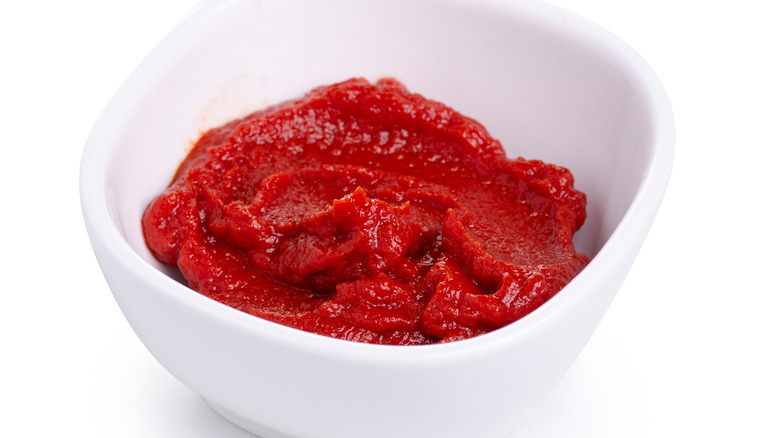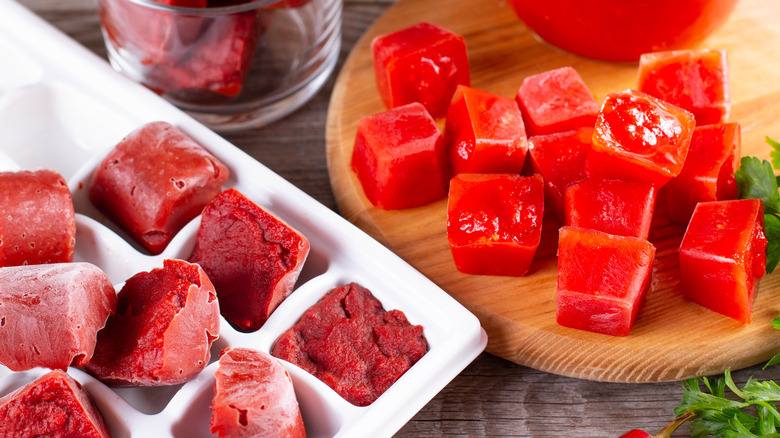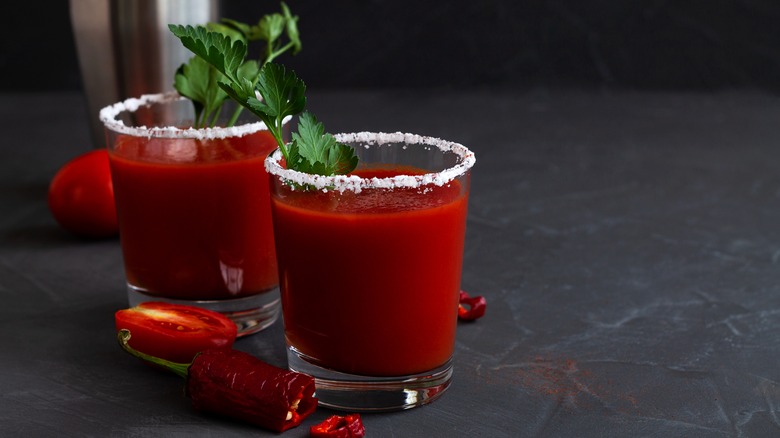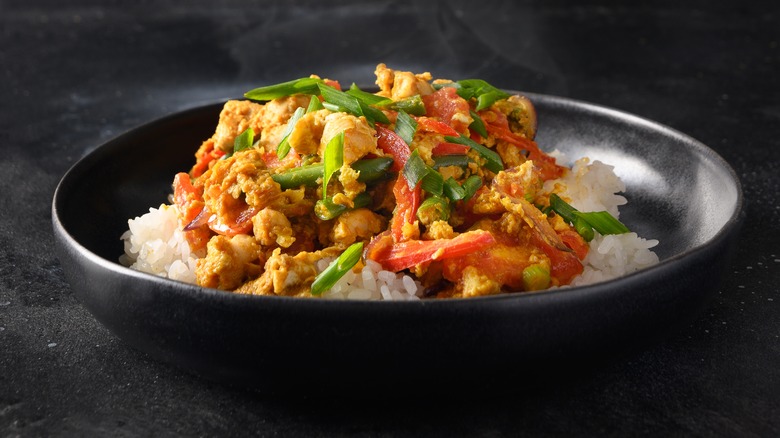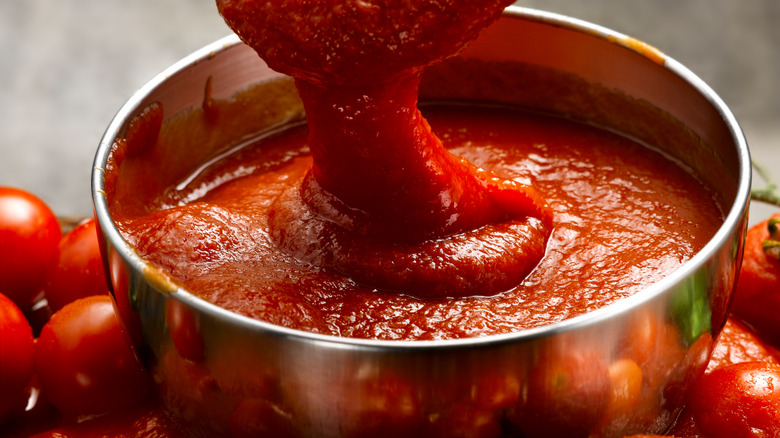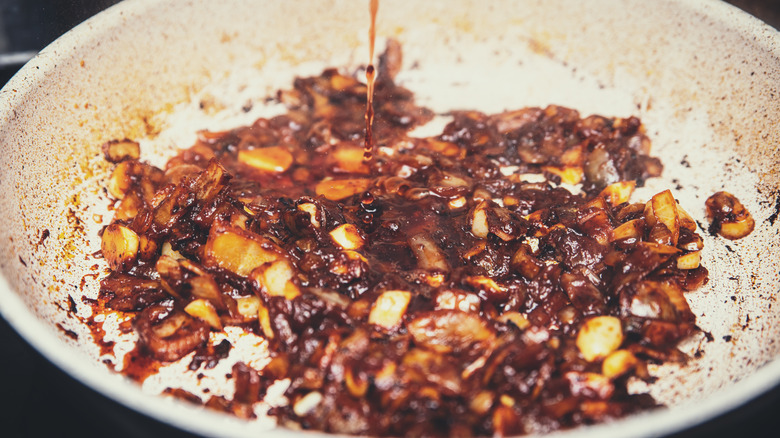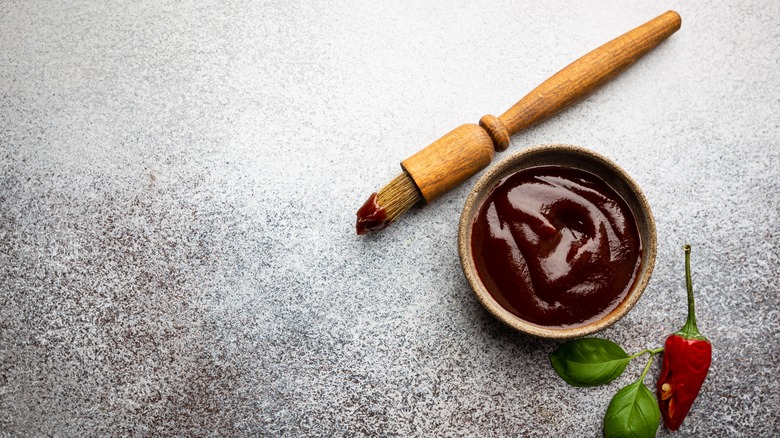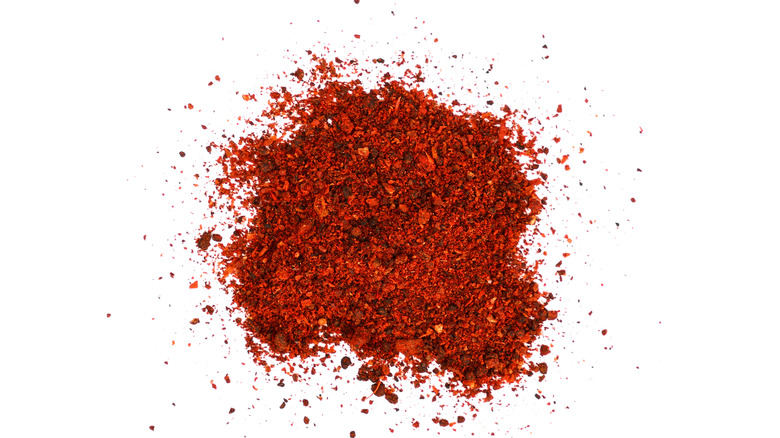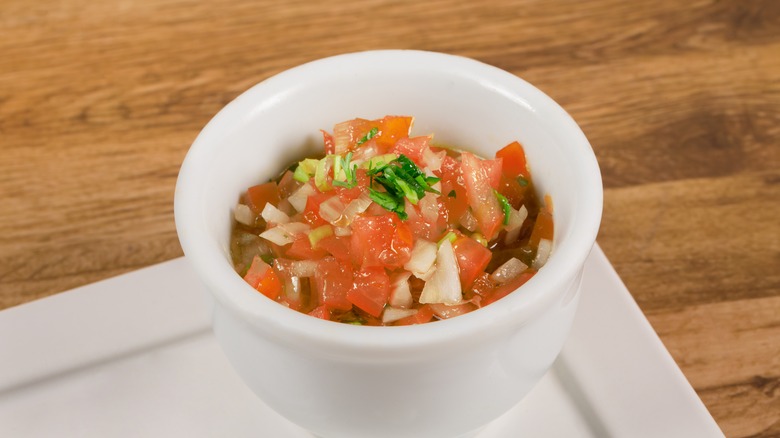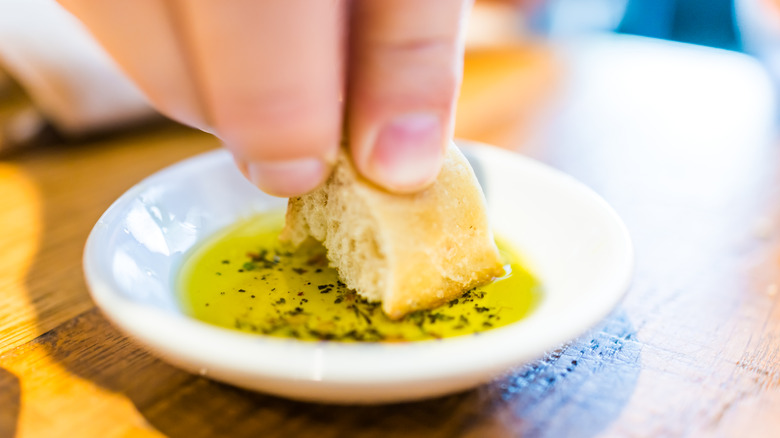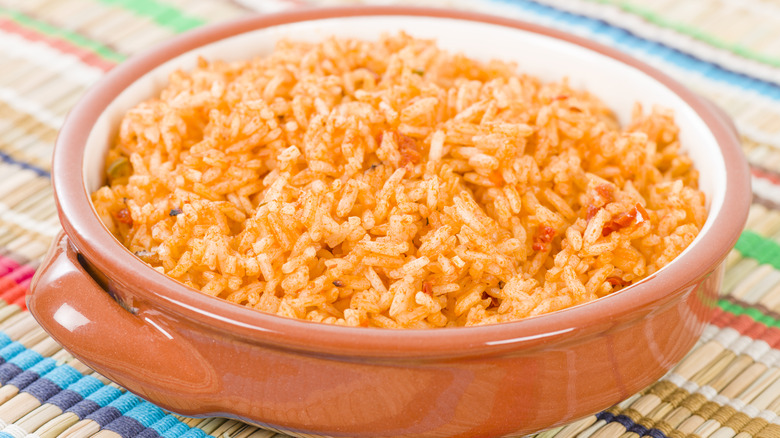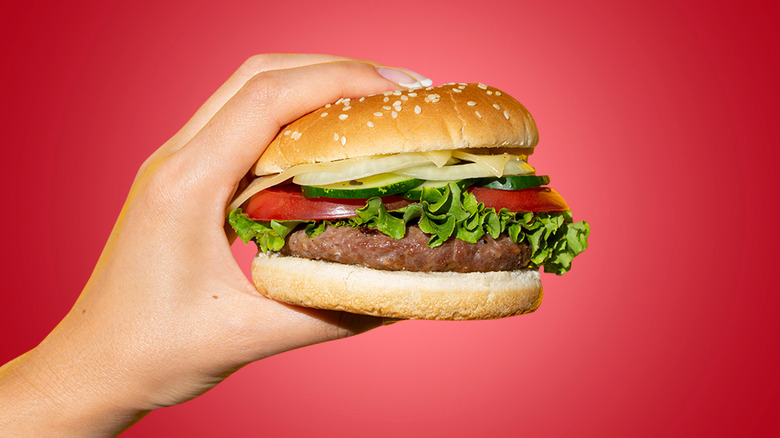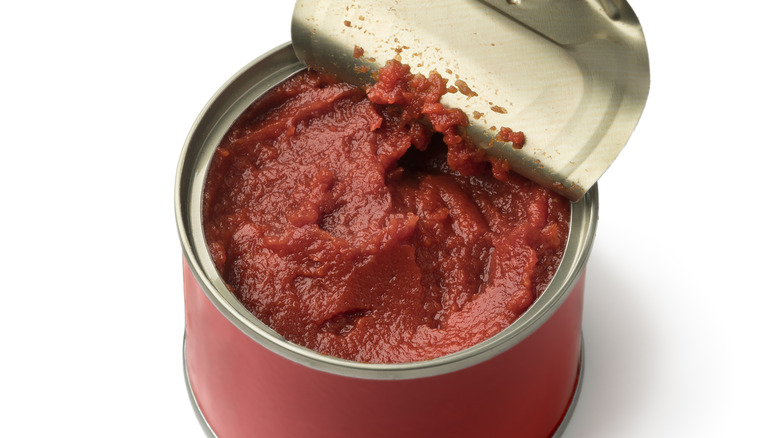What To Do With Leftover Tomato Paste
We may receive a commission on purchases made from links.
If you don't have a can of tomato paste in your kitchen, this is your sign. This thick pantry staple is concentrated in tomato flavor because it's made with tomato pulp — minus the seeds and skins. There's very little liquid in the can, meaning you get the most concentrated flavor in the smallest serving. Although you might think of tomato paste as the best product of its kind ever invented, there is one major problem — rarely will a recipe ever call for an entire container of it. More often, recipes use a tablespoon of the ingredient here and there.
So what do you do with the remaining bit in the can? You could purchase tomato paste in a tube instead, but you will pay a premium compared to the cheap cans of it at the grocery store. Instead, here are some of the creative ways you can use up leftover tomato paste.
Freeze it
Tomato paste is a great ingredient — not only because of its utility in many recipes but also because it can be easily frozen for later use. If you plan to freeze your tomato paste, avoid placing the entire can in the freezer. Not only will this mean that you can't get the rest of the paste outside of the can, but you will also be left in the same predicament as before.
Instead, freeze individual tablespoons of the tomato paste in small pieces of plastic wrap or parchment paper. Then, transfer the small plops to a plastic bag and keep them in your freezer until you need one. You can also add small blobs of tomato paste to a silicon ice cube tray and pop the pieces out when you need to use them. According to Bellalimento, the single servings of tomato paste will last about two to three months in the freezer if properly stored.
Make your own Bloody Mary mix
If you're a cocktail fanatic, you've probably lounged over brunch with a Bloody Mary in tow. These tomato-based cocktails are traditionally made with vodka, tomato juice, hot sauce, lemon juice, and Worcestershire sauce. But, if you have leftover tomato paste, you can make a one-to-four ratio of tomato paste to water to replicate the tomato juice in the standard recipe. You'll get the same flavor as if you used tomato juice but the satisfaction of using up your leftover tomato paste.
Bloody Mary recipes are flexible and can include ingredients outside of the base recipe as well. The Irish variation of the drink contains a few ounces of Guinness beer, while the creamy version uses crème fraîche for a flavor just like tomato soup. You can also alter the garnishes you use for your Bloody Mary beyond celery — a tiny bacon spiral on a toothpick can enhance the savoriness of your boozy beverage.
Add umami flavor to a stir fry sauce
Tomato paste is an ingredient rich in umami — an illusive and complex savory flavor found in foods like meat, fish, and mushrooms. The presence of this taste in the pantry staple makes it a great pairing for other umami-rich foods and seasonings, such as those you'd find in a stir-fry sauce. However, you'll want to avoid adding too much tomato paste so you don't obscure the flavors of the soy sauce, sesame oil, ginger, or garlic — all of which are the stars of the show.
Many Asian stir-fries use tomato as a central ingredient as well. Chinese tomato and egg stir-fry, also called xīhóngshì chǎo jīdàn, is a popular dish in homes and restaurants across the country (via The China Project). While most recipes for this stir-fry meal use whole sliced tomatoes, others add a dose of tomato paste to boost the tomato flavor. The sauce can be reduced into a thick paste or made into a more soupy consistency with more water.
Add a boost to jarred tomato sauce
Jarred tomato sauce can be lackluster in its flavor, despite being made up of (mostly) tomatoes. Luckily, there are some ways you can bolster the taste of your sauce and make your jarred tomato sauce taste a bit more homemade. Besides adding a splash of lemon juice or a bit of vinegar to curb the sauce's sweetness, you can mix in a few tablespoons of tomato paste as your sauce is reheating. It adds a more concentrated flavor and makes your sauce more robust.
If you despise the taste of jarred tomato sauce, you can make your own at home using tomato paste too. Just add a few tablespoons of tomato paste to the sauce as it's cooking. If you use tomato paste as a substitute for tomato sauce, you'll find that the result is a mixture that doesn't soak into the noodles nor liquifies. We've found that adding it as a flavor enhancer rather than a base is more practical.
Use it to help deglaze a pan
Deglazing is a cooking technique that removes small flecks of food from the bottom of a pan after it's finished cooking. The resulting concentrate is rich in flavors and can be repurposed into the recipe. Deglazing the pan after caramelizing onions, for example, is the perfect way to remove the caramelized bits of onion that can impart a lot of flavor into a glaze or a seasoning. Typically, this process is done with wine, vinegar, or broth, but since we're a fan of the flavor, we recommend you use tomato paste.
Today recommends adding a scant amount of tomato paste to the pan after cooking onions, meat, or anything in between. The ingredient will brown in the pan and soak up any residual juices, flavors, or seasonings you used. You can use your deglazed tomato paste in the dish itself, such as in a tomato sauce after cooking the onions, or repurpose it for another delicious recipe.
Make homemade barbecue sauce
Barbecue sauce is a condiment you'll always want to have on hand. Its uses stretch from homemade Southern meatloaf to grilled fish. And with leftover tomato paste, you can make a unique sauce that reflects your regional tastes. The standard barbecue sauce recipe includes vinegar, brown sugar, honey, smoked paprika, and ketchup as the base and the primary flavoring agent. You can substitute the ketchup for tomato paste entirely for a more concentrated flavor, but you will have to adjust the sweetness of the other ingredients to ensure a traditional sweet barbecue sauce flavor. If you don't want to eliminate the ketchup component entirely, substitute equal parts of the ketchup for tomato paste.
According to Does It Go Bad, homemade barbecue sauce will last up to two weeks in the refrigerator. You can also freeze your homemade barbecue sauce in individual servings to extend its shelf life.
Dehydrate it into tomato powder
The texture of tomato paste can limit its utility in the kitchen. But, if you dry tomato paste, you will find it easy to sprinkle it on foods that need a bit of tomato flavor, like fresh french fries or scrambled eggs.
According to The Purposeful Pantry, you'll just need an oven and a food processor to make your own tomato powder at home. The first step to getting the powder is to dry out the tomato paste into "tomato leather." This involves spreading a very thin coating of the paste onto a non-stick baking sheet and heating it in the oven for up to 12 hours at a low temperature. The site recommends flipping the sheet about eight hours in to ensure the leather is dry, not tacky, all around. Since you're going to pulverize the tomato paste into a powder, you'll want the sheet dry and brittle so that it cracks when you try to bend it. After the sheet has dried sufficiently, pulse the pieces in a food processor before returning the granules to the oven for the final drying process. You can store your tomato powder in an airtight container in the refrigerator or in desiccant packs for up to nine months.
Make an umami vinaigrette
A vinaigrette is a perfect way to use up leftover tomato paste and boost the umami taste in your salad dressing. When working with a strongly-flavored ingredient like tomato paste, it is important to add it slowly and regularly taste to ensure the other flavors of your dressing aren't overshadowed. Your other option for making a balanced vinaigrette is to stick with other ingredients that complement tomatoes. Use balsamic vinegar or red wine vinegar to boost the acidity of the tomato paste, and use a neutral flavored oil like avocado or extra virgin olive oil. You can also include herbs in your dressing, like fresh chopped basil, garlic, thyme, or rosemary for a hint of freshness, as well as a pairing of a sweet element like maple syrup or agave.
We recommend tossing your vinaigrette with a cherry tomato Caprese salad. The flavors of this salad are impeccable, and the dressing acts as a fatty, acidic oasis for the rest of the dish.
Combine it with oil and serve with bread
There's not much that's more Italian than grazing on a piece of crusty bread dipped in a good plate of olive oil. If you want to upgrade the flavors of your oil, add a tablespoon or two of tomato paste. This simple ingredient will increase the complexity of your dressing and will complement almost any type of Italian, French, or Dutch oven bread.
Adding tomato paste to dipping oil follows a similar recipe to charred tomato oil. Instead of (or in addition to) the blistered cherry tomatoes, use this ingredient. If you have leftovers from deglazing garlic or peppers, the upgraded tomato paste will add another layer of complexity to your dressing. Fresh oregano and chopped basil can bring more organic flavors to the dish, while oil-cured anchovies include an additional boost of umami flavor. This tomato paste hack is bound to impress your dinner guests and is the perfect pairing for lounging outside on a hot summer day.
Add it to rice or grains
If you're not cooking your grains (which include rice, quinoa, farro, barley, and the like) in broth, now is the time to start. As the grains take in the water, they also take in the richness of the broth. Under the same premise, adding a bit of tomato paste to your grains as they cook can boost their umami flavor and invite new opportunities for dishes. Mexican rice is flavored with tomato sauce; this makes substituting the sauce with paste an easy swap. The major precaution for this, though, is that you'll want to keep the same amount of liquid per the rice package's directions. Since tomato paste is less liquid than sauce, you may need to add a bit more broth to ensure the rice is fluffy and fully cooked.
Quinoa and tomato paste is another match made in heaven. You can stir the tomato paste into the cooking broth to add tomato flavor without skewing the liquid-to-grain ratio. Tomato-y quinoa is delicious when paired with Italian-seasoned chicken breasts and roasted vegetables.
Mix it into a marinade
Instilling flavor is what marinating meat is all about. Including tomato paste in your marinade repertoire can increase the complexity of your dish and help keep the cut moist as it soaks in other flavors.
Steak is one protein that benefits from a marinade because the blend of vinegar and salt helps tenderize it. Add a tablespoon of tomato paste to Worcestershire sauce, soy sauce, lemon juice, vinegar, and oil to help infuse more umami flavor into the cut; just make sure you allocate at least an hour for the beef to soak in the mix before grilling. You can also add a bit of tomato paste to a marinade with red wine and fresh garlic. You can use this overnight blend for steak or chicken, and we can assure you that the combination of fresh herbs like thyme, oregano, star anise, and cinnamon is positively divine.
Use it as a burger topping
No burger is complete without a medley of condiments. Mayonnaise, mustard, and ketchup are three of the most common burger spreads, but if you're looking for a stronger tomato flavor, you should consider adding a schmear of tomato paste. Tomato paste lacks the same sweetness and acidity as ketchup, so you'll get a stronger, more concentrated flavor by doing this.
If you're worried about missing out on the sweetness of the ketchup, we have another tip for you to help instill more sweetness into the burger itself. Add soda to your burgers to improve the caramelization of the patty as it's grilling. You'll need to add about a ½ cup of cola for each 1 to 1½ pounds of ground beef you use. Some of the soda is added to the burger meat, while the rest is brushed onto the exterior just before it's finished cooking.
Make shakshuka
Shakshuka is a popular breakfast dish in Israel. The recipe essentially combines cooked tomato sauce, fresh diced vegetables, and poached eggs — you'll get all the food groups plus a blast of flavor from smoked paprika, cumin, cinnamon, sumac, and coriander. The key to making the perfect shakshuka at home is starting with a dark, deep, flavorful tomato sauce. Our recipe uses both fire-roasted canned tomatoes and whole-roasted tomatoes, but you can add more concentrated flavor by adding a few tablespoons of tomato paste to the sauce as it's cooking.
Although shakshuka may seem like a laborious recipe to make, especially as an early-morning breakfast, the flavor of this dish will truly set it apart from other kinds of egg-based meals. Although it's vegetarian, you can amp up your shakshuka by serving it with bacon, sausage, or a dense, crusty baguette. And most of the dish reheats well (besides the eggs), so you can serve the leftovers later and make fresh eggs the day of.
Add it to a stew or a curry
Tomato is the perfect umami flavor you need to add to your next stew or curry. Using tomato as a base for curry pairs well with spicy ingredients like chili peppers and can provide a bit of heat to your meal. Plus, curry is a modifiable dish, so you can add your favorite proteins or vegetables depending on what kind of flavor you want to impart. We recommend adding a tablespoon of tomato paste to your vegetable coconut curry. While this recipe already has a can of chopped tomatoes, adding the additional boost from the tomato paste rounds out the recipe's profile.
You can also steer towards adding tomato paste to your stew. Start by browning the tomato paste in a pan until it darkens. This will pull out some of the tartness and produce a smoother flavor when mixed with chuck steak and vegetables.
When it's time to throw your tomato paste out
All good things must come to an end — it's why we recommend tossing your can of tomato paste if you can't remember how long it's been in your refrigerator. Once you open it, you should keep it refrigerated and covered with plastic wrap or in an airtight or glass container. But even so, according to StillTasty, opened, refrigerated tomato paste can only last anywhere from five to seven days. Unopened, it can last until the best-by date listed on the can, and while you can eat tomato paste that has gone beyond the best-by date, the product may no longer be at peak quality.
Spoiled tomato paste will usually emit a peculiar odor or show obvious signs of mold. You should discard any unopened cans that have evidence of damaging or bulging; this may indicate the contents inside have gone bad already and may make you sick.
